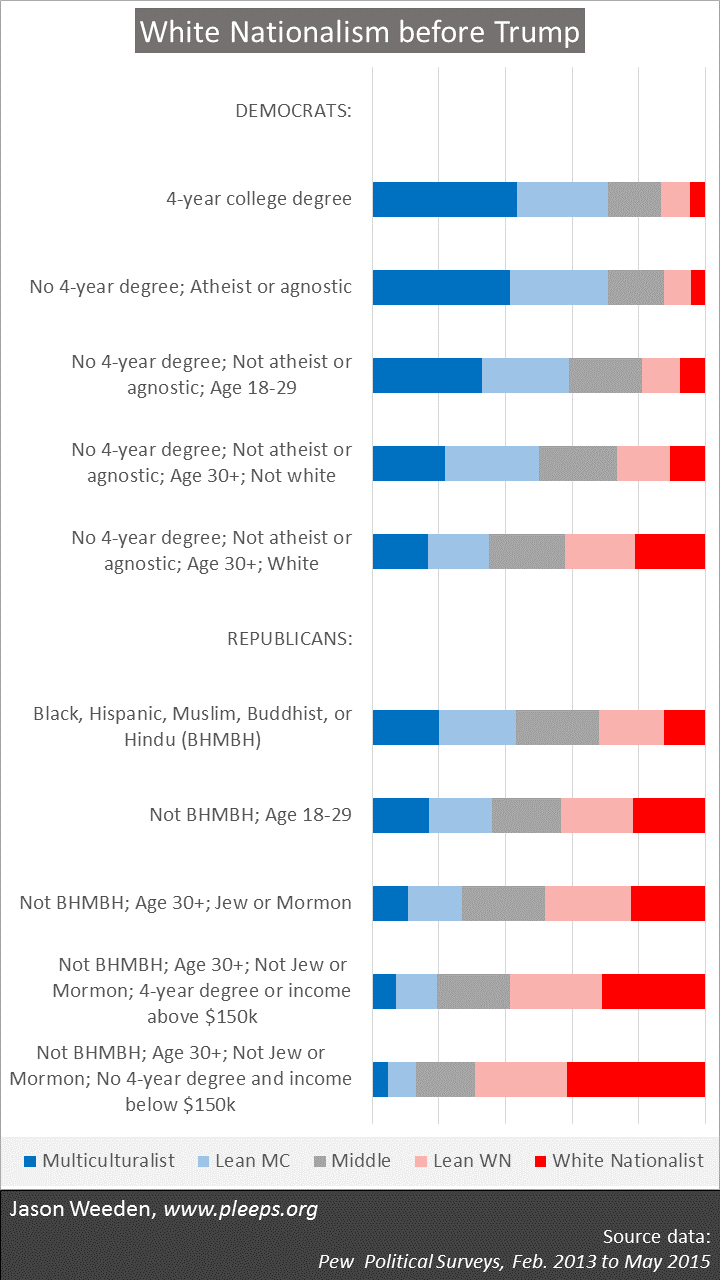Political parties are messy coalitions that are pretty much constantly changing. They involve various demographic and interest groups with a hodgepodge of policy preferences. When we look at periods in which the policies and priorities of the parties change substantially, we often see that some people cross party lines when voting and, if the changes last, even flip their party identities.
It seems relatively clear that the U.S. is now in one of these periods of heightened change. The Republican party has been relatively more opposed to civil rights for minorities since the 1960s, and relatively more opposed to immigration since the 1990s, and relatively more suspicious of Muslims since the 2000s. But these kinds of white nationalist positions haven’t been the party’s main focus. The candidacy of Donald Trump has changed that, at least for the moment.
This Republican shift opens up risks and opportunities for both major parties. Before Trump, Republicans were more likely than Democrats to hold white nationalist views—combining conservative positions on immigration, race, Islam, and related areas—but there have remained substantial internal differences within both parties. So it seems likely that this presidential election will involve some shifts in prior voting patterns.
To get specific, here I’ll look at white nationalist views within the parties in the period immediately prior to Trump, who announced his candidacy in June of 2015. I’m using Pew political data from February 2013 to May 2015. I created an overall measure of white nationalist views based on a couple dozen individual survey questions—the measure is based primarily on opinions on immigration and secondarily on opinions regarding equal rights for blacks, and also contains a few items on views on Muslims, terrorism, and free trade. It’s a combined profile of the essential core of Trump’s campaign.
So, before Trump, who were the Democrats and who were the Republicans for whom this white nationalist agenda had the most and least appeal? Who, that is, should we expect to be most and least likely to cross their old party lines in this election given the new change in policy focus?
I first split the sample into Democrats (including Democratic leaners) and Republicans (including Republican leaners). I then explored the demographic predictors (in each side separately) of positions on my overall white nationalism measure. Based on this analysis, I divided both sides’ supporters into five subgroups, shown in the chart below.
 (Technical notes: Sample size is 23,667. Results are weighted. “White” is non-Hispanic white. For ease of visual interpretation, I defined the top 20% of the overall sample on the policy scale as “White Nationalist” and the bottom 20% as “Multiculturalist,” with the other quintiles represented by the three middle categories.)
(Technical notes: Sample size is 23,667. Results are weighted. “White” is non-Hispanic white. For ease of visual interpretation, I defined the top 20% of the overall sample on the policy scale as “White Nationalist” and the bottom 20% as “Multiculturalist,” with the other quintiles represented by the three middle categories.)
The big themes: Ethnicity, education, and age
By initially splitting the sample into Democrats and Republicans, there’s already a lot of demographic information built in here. The pre-Trump Republicans are more likely to be whites who are Evangelical, wealthier, and/or men (especially whites with middle-of-the-road levels of education). The pre-Trump Democrats are more likely to be non-whites or whites who are non-Christian, poorer, and/or women (especially whites in these categories who have more education).
When we look within these coalitions at white nationalist views, the main divisions involve ethnicity, education, and age. In both parties before Trump, we see splits such that non-whites, those with more education, and younger folks were less likely to favor white nationalist policies than older whites with less education.
On the Democratic side before Trump, those already most opposed to white nationalist policies were the college-educated, atheists and agnostics, Millennials, and non-whites. But when we look at the group to which none of these apply, we actually we a Democratic group that contains more folks supportive of white nationalist policies than opposed.
On the Republican side before Trump, those who were most likely to oppose white nationalist policies were blacks, Hispanics, Muslims, Buddhists, and Hindus, followed by young folks, followed by Jews and Mormons, followed by those who either have college degrees or are wealthier. The remaining group are the bulk of Republicans, who showed the most support for white nationalist policies before Trump—these are mostly older, less-educated, non-rich, white Christians.
Sometimes the obvious idea goes a long way
So what accounts for Trump’s appeal? What accounts for the recent spate of general election polls showing him doing particularly poorly with minorities, and weaker-than-usual with college-educated whites, but with tremendous appeal to less-educated whites?
Commentators have proposed a number of ideas, but there’s an obvious core here that shouldn’t be forgotten. Before Trump announced his candidacy, the kind of white nationalist agenda he has emphasized was already most popular among less-educated and older whites and least popular among the better educated, minorities, and younger folks. Trump hasn’t completely reorganized the parties’ policy positions, but he has introduced a new prioritization of white nationalist policies. So this will likely lead to some shifts in prior voting patterns.
There’s more going on in this election than just this change in white nationalist policy focus, of course. But sometimes the basics aren’t that complicated. Some people are supporting Trump—even some Democrats—because he’s pushing an agenda they already supported. And some people are opposing Trump—even some Republicans—because he’s pushing an agenda they already opposed.
